An introduction to use the domain mode of the current release of WildFly
I recently tried to play with the domain mode in the current release of WildFly, version 35, while writing this blog post.
According to the blog post written by Brian Stansberry[1], there are some breaking backward-compatibility changes in the security configuration part related to Elytron since WildFly 25:
A key focus in WildFly 25 has been completing our migration away from the legacy security layer that dates back to JBoss AS and onto the WildFly Elytron based security layer introduced in WildFly 11. SE 17 does not provide packages that legacy security heavily relies upon, so the time has come to complete the transition off of legacy security.
Nevertheless, the resources I could find are mostly outdated or don’t contain the step-by-step walkthrough about the minimal configuration to be done for using the domain mode of WildFly. I have written a book before, explaining the domain mode usage of WildFly[2]. There is also a relative document about the domain mode setup[3]. All these materials are outdated on the domain configuration topic, so I’d like to update the knowledge on this topic in this blog post, showing how to configure the domain mode for the most recent version of WildFly server, which is version 35 when I’m writing this blog post. I won’t cover all the detail usages of the domain mode in this blog post, but it will be a good start to follow the instructions in this blog posts for the further studies.
Here is my local environment setup to use the domain mode of the WildFly server:

As the deployment diagram shows above, I used two machines to run the WildFly server in domain mode. In the above setup, the WildFly server running on Machine A acts as a domain controller, and the WildFly server on Machine B will be connected to Machine A accepting the management from the domain server.
The host name of the WildFly server running on Machine A will be configured to primary(this will be defined in the name property in the host.xml), and the host name of the WildFly server running on Machine B will be configured to secondary.
Both WildFly servers, running on two different machines, will be configured to run a managed server (defined in the server section of the host.xml) within the same server group, named other-server-group.
The Primary Host Controller will define a server-three managed server, while the Secondary Host Controller will define a server-two managed server, both belonging to the other-server-group server group.
In this way, the Domain Controller can manage the server group and deploy user applications to the managed servers within it, even though the managed servers are running on different hosts.
The first step is to download the current version of WildFly. I will use version 35.0.0.Final version in this blog post which is the newest final version when I’m writing this blog post. Here is the release page:
❯ wget https://github.com/wildfly/wildfly/releases/download/35.0.0.Final/wildfly-35.0.0.Final.zipAfter the WildFly server zip file is downloaded and extracted into both machines, I can do the configuration work. The extracted WildFly server directory has some of the configuration files out-of-box. Here are the domain configurations provided:
❯ ls wildfly-35.0.0.Final/domain/configuration/
application-roles.properties host-secondary.xml
application-users.properties host.xml
default-server-logging.properties logging.properties
domain.xml mgmt-groups.properties
host-primary.xml mgmt-users.propertiesFrom the above command output, we can see in the wildfly-35.0.0.Final/domain/configuration/ directory, it contains host-primary.xml and host-secondary.xml files. I will use host-secondary.xml with some modifications in Machine B. However, I’ll use the host.xml instead of host-primary.xml in Machine A, because host-primary.xml has removed all the servers configuration, but we need these servers configuration in our setup. However, I still need to configure a Managed Server in Machine A for demonstration purposes.
First, let’s check the host.xml on Machine A to fit the requirement. In host.xml, the host name is set to primary by default:
<host xmlns="urn:jboss:domain:community:20.0" name="primary">This is what I expect, so I don’t need to change it.
Instead of directly editing the configuration file, we can use the jboss-cli.sh to connect to the server to edit the configuration file in a more controllable way. To do this, we can first run the jboss-cli.sh:
❯ pwd
/Users/weli/works/wildfly-35.0.0.Final/bin
weli@192 ~/works/wildfly-35.0.0.Final/bin
❯ ./jboss-cli.sh
You are disconnected at the moment. Type 'connect' to connect to the server or 'help' for the list of supported commands.
[disconnected /]After entering the CLI, run the following command to connect to the host controller:
[disconnected /] embed-host-controller
[domain@embedded /]The above command will run the domain server in offline-mode(To learn about the detailed usages of the above command, you can read this blog post[4]). And we can now configure the server in the CLI, and all the changes will be persisted into the host controller configuration file(by default it’s host.xml).
Now we can use the CLI to read the host name:
[domain@embedded /] /:read-attribute(name=local-host-name)
{
"outcome" => "success",
"result" => "primary"
}It’s preferred to use CLI command instead of directly operating on the host controller configuration file. In the rest of this blog post, I’ll introduce both the content of the host controller file, and the way to use the CLI command to modify it.
Now we can see the host.xml file has two servers settings by default:
<server name="server-one" group="main-server-group"/>
<server name="server-two" group="main-server-group" auto-start="true">
<jvm name="default"/>
<socket-bindings port-offset="150"/>
</server>
<server name="server-three" group="other-server-group" auto-start="false">
<jvm name="default"/>
<socket-bindings port-offset="250"/>
</server>I’ll use only server-three in this blog post, so I comment out the server-one and the server-two definitions and only leave the server-three definition here.
Here are the commands to disable the server-one and server-two from auto-starting:
[domain@embedded /] /host=primary/server-config=server-one:write-attribute(name=auto-start, value=false)
{
"outcome" => "success",
"result" => undefined,
"server-groups" => undefined
}
[domain@embedded /] /host=primary/server-config=server-two:write-attribute(name=auto-start, value=false)
{
"outcome" => "success",
"result" => undefined,
"server-groups" => undefined
}
[domain@embedded /]Alternatively, you can use these commands to remove the server-one and server-two directly:
/host=primary/server-config=server-one:remove
/host=primary/server-config=server-two:removeIn addition, there are several interface properties defined in the host.xml file that we need to override during runtime. Here is the interfaces section in the host.xml:
<interfaces>
<interface name="management">
<inet-address value="${jboss.bind.address.management:127.0.0.1}"/>
</interface>
<interface name="public">
<inet-address value="${jboss.bind.address:127.0.0.1}"/>
</interface>
</interfaces>I checked my IP address of Machine A, and it’s 192.168.0.115, so I started the WildFly Server on Machine A by running the following commands in the bin directory of WildFly:
$ pwd
/wildfly-35.0.0.Final/bin$ ./domain.sh --host-config=host.xml -Djboss.bind.address.management=192.168.0.115 -Djboss.bind.address=192.168.0.115 -Djboss.domain.primary.address=192.168.0.115Please note that the host.xml is the default value for the --host-config argument. So in this specific case we don’t have to add it.
And I can see the server is started and here is the server log output of the above command:
=========================================================================
JBoss Bootstrap Environment
JBOSS_HOME: /wildfly-35.0.0.Final
JAVA: .sdkman/candidates/java/current/bin/java
JAVA_OPTS: -Xms64m -Xmx512m -Djava.net.preferIPv4Stack=true -Djboss.modules.system.pkgs=org.jboss.byteman -Djava.awt.headless=true -Djdk.serialFilter="maxbytes=10485760;maxdepth=128;maxarray=100000;maxrefs=300000" --add-exports=java.desktop/sun.awt=ALL-UNNAMED --add-exports=java.naming/com.sun.jndi.ldap=ALL-UNNAMED --add-exports=java.naming/com.sun.jndi.url.ldap=ALL-UNNAMED --add-exports=java.naming/com.sun.jndi.url.ldaps=ALL-UNNAMED --add-exports=jdk.naming.dns/com.sun.jndi.dns=ALL-UNNAMED --add-opens=java.base/java.lang=ALL-UNNAMED --add-opens=java.base/java.lang.invoke=ALL-UNNAMED --add-opens=java.base/java.lang.reflect=ALL-UNNAMED --add-opens=java.base/java.io=ALL-UNNAMED --add-opens=java.base/java.net=ALL-UNNAMED --add-opens=java.base/java.security=ALL-UNNAMED --add-opens=java.base/java.util=ALL-UNNAMED --add-opens=java.base/java.util.concurrent=ALL-UNNAMED --add-opens=java.management/javax.management=ALL-UNNAMED --add-opens=java.naming/javax.naming=ALL-UNNAMED -Djava.security.manager=allow
=========================================================================
17:06:49,064 INFO [org.jboss.modules] (main) JBoss Modules version 2.1.6.Final
17:06:49,405 INFO [org.jboss.threads] (main) JBoss Threads version 2.4.0.Final
17:06:49,428 INFO [org.jboss.as.process.Host Controller.status] (main) WFLYPC0018: Starting process 'Host Controller'
17:06:49,896 INFO [org.jboss.as.process.Host Controller.system.stdout] (stdout for Host Controller) [Host Controller] 17:06:49,875 INFO [org.jboss.modules] (main) JBoss Modules version 2.1.6.Final
[Host Controller] 17:06:50,385 INFO [org.jboss.msc] (main) JBoss MSC version 1.5.5.Final
[Host Controller] 17:06:50,393 INFO [org.jboss.threads] (main) JBoss Threads version 2.4.0.Final
[Host Controller] 17:06:50,441 INFO [org.jboss.as] (MSC service thread 1-2) WFLYSRV0049: WildFly 35.0.0.Final (WildFly Core 27.0.0.Final) starting
[Host Controller] 17:06:50,806 INFO [org.wildfly.security] (Controller Boot Thread) ELY00001: WildFly Elytron version 2.6.0.Final
[Host Controller] 17:06:51,088 INFO [org.jboss.as.host.controller] (Controller Boot Thread) WFLYHC0003: Creating http management service using network interface (management) port (9990) securePort (-1)
[Host Controller] 17:06:51,099 INFO [org.xnio] (MSC service thread 1-3) XNIO version 3.8.16.Final
[Host Controller] 17:06:51,103 INFO [org.xnio.nio] (MSC service thread 1-3) XNIO NIO Implementation Version 3.8.16.Final
[Host Controller] 17:06:51,139 INFO [org.jboss.remoting] (MSC service thread 1-7) JBoss Remoting version 5.0.30.Final
[Host Controller] 17:06:52,510 INFO [org.jboss.as] (Controller Boot Thread) WFLYSRV0062: Http management interface listening on http://192.168.0.115:9990/management and https://192.168.0.115:-1/management
[Host Controller] 17:06:52,510 INFO [org.jboss.as] (Controller Boot Thread) WFLYSRV0053: Admin console listening on http://192.168.0.115:9990 and https://192.168.0.115:-1
[Host Controller] 17:06:52,546 INFO [org.jboss.as] (Controller Boot Thread) WFLYSRV0025: WildFly 35.0.0.Final (WildFly Core 27.0.0.Final) (Host Controller) started in 3066ms - Started 70 of 71 services (14 services are lazy, passive or on-demand) - Host Controller configuration files in use: domain.xml, host.xml - Minimum feature stability level: communityFrom the above server log output, I can see the server-bound address is 192.168.0.115 instead of the default 127.0.0.1. Then I opened another terminal window and ran the following command in the bin directory of the WildFly server:
$ ./add-user.sh -u admin -p 123
Added user 'admin' to file '/wildfly-35.0.0.Final/standalone/configuration/mgmt-users.properties'
Added user 'admin' to file '/wildfly-35.0.0.Final/domain/configuration/mgmt-users.properties'From the above command output, we can see the admin user is added and its password is 123. This added user will be used on the Secondary Host Controller to connect to the Primary Host controller.
Please note that the above command didn’t generate a secret value related to the generated admin user as described you may find in the other online materials, which is already deprecated since WildFly 25. So the following secret configuration on the Secondary Host Controller is already deprecated:
<server-identities>
<secret value="..." />
</server-identities>As the Primary Host Controller is started on Machine A, now we can check the WildFly server configuration on Machine B. As planned, the Host Controller is named secondary, and it will be connected to the Primary Host Controller on Machine A, which acts as the domain controller.
Now we can check the configuration on the Secondary Host Controller. The Secondary Host Controller on Machine B will use the host-secondary.xml file as its configuration file. Please note that to edit the host-secondary.xml file in CLI, you should use this command to connect to the embedded server and use the correct host controller file:
[disconnected /] embed-host-controller --host-config=host-secondary.xml
[domain@embedded /]We need to make some modifications to this file. First I need to add the name property to the host section:
<host xmlns="urn:jboss:domain:community:20.0" name="secondary">Here is the method to use the CLI command to modify the host controller name:
$ ./wildfly-35.0.0.Final/bin/jboss-cli.sh
You are disconnected at the moment. Type 'connect' to connect to the server or 'help' for the list of supported commands.
[disconnected /] embed-host-controller --host-config=host-secondary.xml
[domain@embedded /] /host=unknown-host.unknown-domain:write-attribute(name=name,value=secondary)
{
"outcome" => "success",
"result" => undefined,
"server-groups" => undefined,
"response-headers" => {"process-state" => "reload-required"}
}[domain@embedded /] /host=unknown-host.unknown-domain:reload(admin-only=true)
{"outcome" => "success"}Please note that if you use tab complete, it should autocomplete your default host name. Giving the host a name can help to analyze the server log output later.
So I need to define this authentication-context in the elytron subsystem. This configuration is different from the legacy authentication. Here are the details:
<profile>
<subsystem xmlns="urn:jboss:domain:core-management:1.0"/>
<subsystem xmlns="urn:wildfly:elytron:community:18.0" final-providers="combined-providers"
disallowed-providers="OracleUcrypto" register-jaspi-factory="false">
<authentication-client>
<authentication-configuration sasl-mechanism-selector="DIGEST-MD5" name="myConfig"
authentication-name="admin" realm="ManagementRealm">
<credential-reference clear-text="123"/>
</authentication-configuration>
<authentication-context name="myCtx">
<match-rule match-host="${jboss.domain.primary.address}" authentication-configuration="myConfig"/>
</authentication-context>
</authentication-client>
...
</subsystem>
...
</profile>Here is the equivalent CLI command to do the configuration:
[domain@embedded /] /host=secondary/subsystem=elytron/authentication-configuration=myConfig:add(sasl-mechanism-selector=DIGEST-MD5, authentication-name=admin, realm=ManagementRealm, credential-reference={clear-text="123"})
{"outcome" => "success"}[domain@embedded /] /host=secondary/subsystem=elytron/authentication-context=myCtx:add(match-rules=[{match-host="${jboss.domain.primary.address}", authentication-configuration=myConfig}])
{"outcome" => "success"}The above configuration shows how to configure the elytron subsystem to provide user admin and its password 123 for usage. The authentication-configuration section is added, and the authentication context myCtx is using this configuration. Please note this is only one way to provide username and password via the Elytron subsystem, and you can avoid using clear-text to provide the password. I won’t dig into more details on how to use Elytron in this blog post, but you can always refer to its document to learn its usage[5].
Then I need to add modify configuration of the domain-controller:
<domain-controller>
<remote authentication-context="myCtx">
<discovery-options>
<static-discovery name="primary" protocol="${jboss.domain.primary.protocol:remote+http}"
host="${jboss.domain.primary.address}" port="${jboss.domain.primary.port:9990}"/>
</discovery-options>
</remote>
</domain-controller>As the configuration is shown above, I defined the authentication-context to be used as myCtx. Here is the equivalent CLI command to do the configuration:
/host=secondary:write-attribute(name=domain-controller.remote.authentication-context, value=myCtx)
{
"outcome" => "success",
"result" => undefined,
"server-groups" => undefined,
"response-headers" => {"process-state" => "reload-required"}
}After configuring the authentication part in the host-secondary.xml file on Machine B, the last thing is that I disabled the server-one and left only server-two in the configuration:
<servers>
<!-- <server name="server-one" group="main-server-group"/> -->
<server name="server-two" group="other-server-group">
<socket-bindings port-offset="150"/>
</server>
</servers>Again it’s better to use the CLI command to do the configuration:
/host=secondary/server-config=server-one:removeUntil now all the configurations are done, and then I can start the WildFly server on Machine B with the following command:
❯ ./domain.sh --host-config=host-secondary.xml -Djboss.bind.address.management=192.168.0.113 -Djboss.bind.address=192.168.0.113 -Djboss.domain.primary.address=192.168.0.115In the above command, I assign the value host-secondary.xml to the host-config property, and I assign values of jboss.bind.address.management and jboss.bind.address as 192.168.0.113, which is the IP address of Machine B itself. I assigned the value of jboss.domain.primary.address as 192.168.0.115, which is the IP address of Machine A. On Machine A, there is a WildFly server running as a domain controller as described above. Now we can see the server log output of the above command from Machine B:
=========================================================================
JBoss Bootstrap Environment
JBOSS_HOME: /wildfly-35.0.0.Final
JAVA: .sdkman/candidates/java/current/bin/java
JAVA_OPTS: -Xms64m -Xmx512m -Djava.net.preferIPv4Stack=true -Djboss.modules.system.pkgs=org.jboss.byteman -Djava.awt.headless=true -Djdk.serialFilter="maxbytes=10485760;maxdepth=128;maxarray=100000;maxrefs=300000" --add-exports=java.desktop/sun.awt=ALL-UNNAMED --add-exports=java.naming/com.sun.jndi.ldap=ALL-UNNAMED --add-exports=java.naming/com.sun.jndi.url.ldap=ALL-UNNAMED --add-exports=java.naming/com.sun.jndi.url.ldaps=ALL-UNNAMED --add-exports=jdk.naming.dns/com.sun.jndi.dns=ALL-UNNAMED --add-opens=java.base/java.lang=ALL-UNNAMED --add-opens=java.base/java.lang.invoke=ALL-UNNAMED --add-opens=java.base/java.lang.reflect=ALL-UNNAMED --add-opens=java.base/java.io=ALL-UNNAMED --add-opens=java.base/java.net=ALL-UNNAMED --add-opens=java.base/java.security=ALL-UNNAMED --add-opens=java.base/java.util=ALL-UNNAMED --add-opens=java.base/java.util.concurrent=ALL-UNNAMED --add-opens=java.management/javax.management=ALL-UNNAMED --add-opens=java.naming/javax.naming=ALL-UNNAMED -Djava.security.manager=allow
=========================================================================
17:17:30,558 INFO [org.jboss.modules] (main) JBoss Modules version 2.1.6.Final
17:17:30,668 INFO [org.jboss.threads] (main) JBoss Threads version 2.4.0.Final
17:17:30,677 INFO [org.jboss.as.process.Host Controller.status] (main) WFLYPC0018: Starting process 'Host Controller'
17:17:30,855 INFO [org.jboss.as.process.Host Controller.system.stdout] (stdout for Host Controller) [Host Controller] 17:17:30,847 INFO [org.jboss.modules] (main) JBoss Modules version 2.1.6.Final
[Host Controller] 17:17:31,008 INFO [org.jboss.msc] (main) JBoss MSC version 1.5.5.Final
[Host Controller] 17:17:31,010 INFO [org.jboss.threads] (main) JBoss Threads version 2.4.0.Final
[Host Controller] 17:17:31,026 INFO [org.jboss.as] (MSC service thread 1-1) WFLYSRV0049: WildFly 35.0.0.Final (WildFly Core 27.0.0.Final) starting
[Host Controller] 17:17:31,158 INFO [org.wildfly.security] (Controller Boot Thread) ELY00001: WildFly Elytron version 2.6.0.Final
[Host Controller] 17:17:31,270 INFO [org.jboss.as.host.controller] (Controller Boot Thread) WFLYHC0003: Creating http management service using network interface (management) port (9990) securePort (-1)
[Host Controller] 17:17:31,275 INFO [org.xnio] (MSC service thread 1-7) XNIO version 3.8.16.Final
[Host Controller] 17:17:31,278 INFO [org.xnio.nio] (MSC service thread 1-7) XNIO NIO Implementation Version 3.8.16.Final
[Host Controller] 17:17:31,289 INFO [org.jboss.remoting] (MSC service thread 1-7) JBoss Remoting version 5.0.30.Final
[Host Controller] 17:17:32,666 INFO [org.jboss.as.host.controller] (Controller Boot Thread) WFLYHC0148: Connected to the domain controller at remote+http://192.168.0.115:9990
[Host Controller] 17:17:32,692 INFO [org.jboss.as.host.controller] (Controller Boot Thread) WFLYHC0023: Starting server server-two
17:17:32,800 INFO [org.jboss.as.process.Server:server-two.status] (ProcessController-threads - 3) WFLYPC0018: Starting process 'Server:server-two'
[Host Controller] 17:17:33,442 INFO [org.jboss.as.host.controller] (management task-1) WFLYHC0021: Server [Server:server-two] connected using connection [Channel ID 20a1192c (inbound) of Remoting connection 79a44d09 to 192.168.0.113/192.168.0.113:61942 of endpoint "secondary:MANAGEMENT" <6894739b>]
[Host Controller] 17:17:33,452 INFO [org.jboss.as] (Controller Boot Thread) WFLYSRV0062: Http management interface listening on http://192.168.0.113:9990/management and https://192.168.0.113:-1/management
[Host Controller] 17:17:33,452 INFO [org.jboss.as] (Controller Boot Thread) WFLYSRV0054: Admin console is not enabled
[Host Controller] 17:17:33,453 INFO [org.jboss.as] (Controller Boot Thread) WFLYSRV0025: WildFly 35.0.0.Final (WildFly Core 27.0.0.Final) (Host Controller) started in 2754ms - Started 70 of 71 services (14 services are lazy, passive or on-demand) - Host Controller configuration file in use: host-secondary.xml - Minimum feature stability level: community
[Host Controller] 17:17:33,453 INFO [org.jboss.as.host.controller] (server-registration-threads - 1) WFLYHC0020: Registering server server-twoFrom the above server log output on Machine B, we can see the WildFly server is started and server-two is started. In addition, it’s connected to the Domain Controller on Machine A. Here is the server log output from the WildFly server on Machine A:
[Host Controller] 17:17:32,549 INFO [org.jboss.as.domain.controller] (Host Controller Service Threads - 23) WFLYHC0019: Registered remote secondary host "secondary", JBoss WildFly 35.0.0.Final (WildFly 27.0.0.Final)From the above Primary Host Controller log output, I can see the secondary host is connected, so it starts to accept the management of Primary Host Controller, which acts as the domain controller. Now I can open the web browser on Machine A to access the WildFly server admin console: http://192.168.0.115:9990
Please note that I can’t use the IP address 127.0.0.1 here, because the WildFly server is listening to the public IP address of Machine A, which we have assigned to the jboss.bind.address.management property during the server startup process. Here is the screenshot of the admin page of the WildFly server:

We need to enter admin as the username and 123 as the password, which is the user we added as the management user above. And then we can enter the admin page of the server:

As we have entered the WildFly admin page, we can try to deploy an example application. There is a helloworld project in the WildFly Quickstart project:
The above project is a simple application that just contains a servlet that will respond with the text <h1>Hello World!</h1> to the request. So I cloned the WildFly Quickstart project into my local environment and then built the helloworld project to generate the helloworld.war:
$ pwd
/wildfly-quickstart/helloworld$ mvn install
...
[INFO] BUILD SUCCESS
...❯ ls target/*.war
target/helloworld.warAs the project is built, I can deploy the above WAR file into the WildFly server group. So I go back to the WildFly admin page, and then I can click the Deployments on the top menu and click the Upload Deployment:

From the above screenshot, you can see that I tried to deploy the sample project into the other-server-group. I use this server group because I have configured servers on both Primary Host Controller and Secondary Host Controller hosts into this server group. Here is the deployment diagram for the server group:
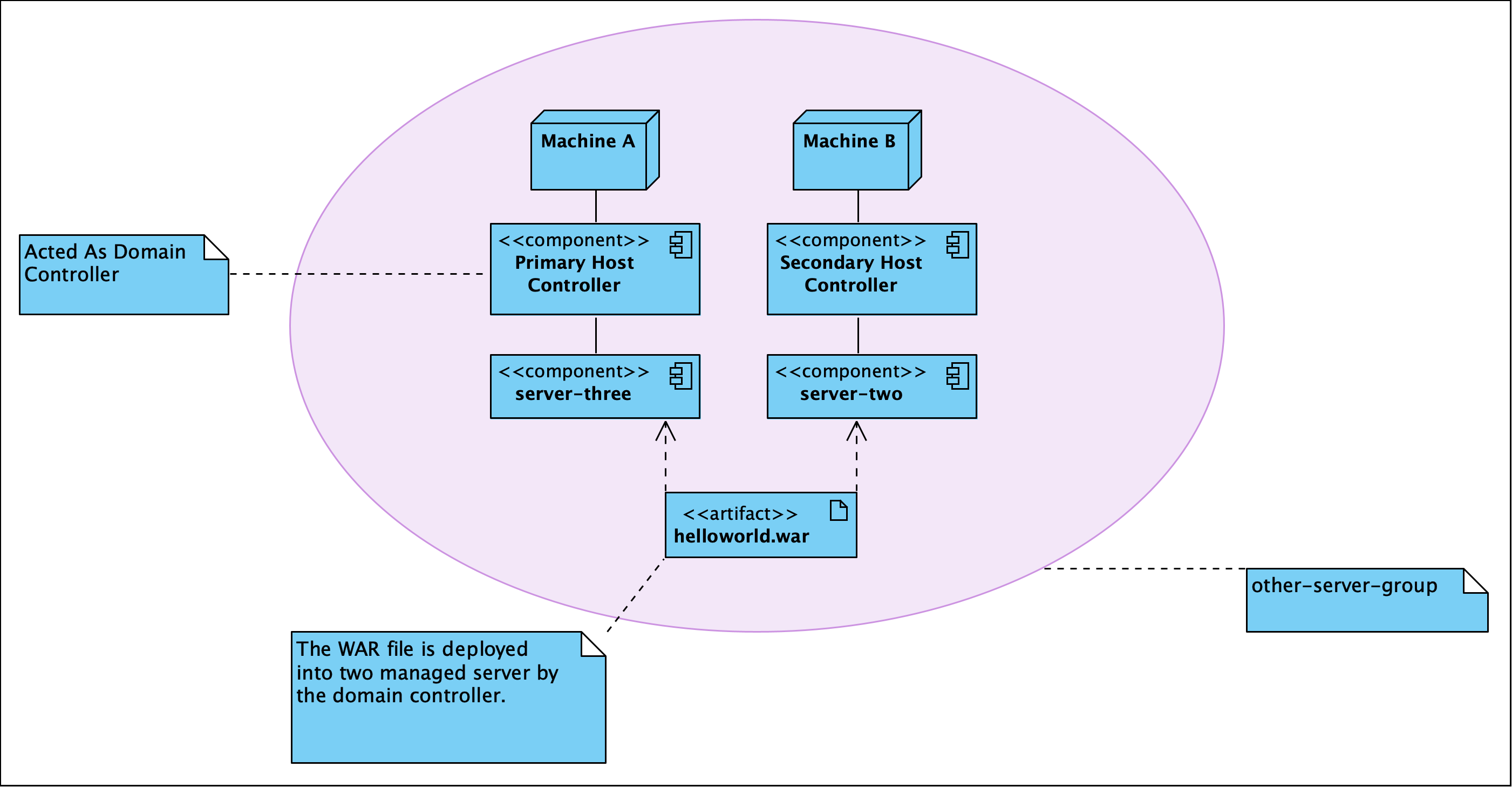
As the diagram shown above, I will use the domain controller’s admin page to deploy helloworld.war into the other-server-group, so the project will be deployed to server-two and server-three, because they both belong to other-server-group. Coming back to the WildFly admin page, I drag and drop the helloworld.war into the deployment page:
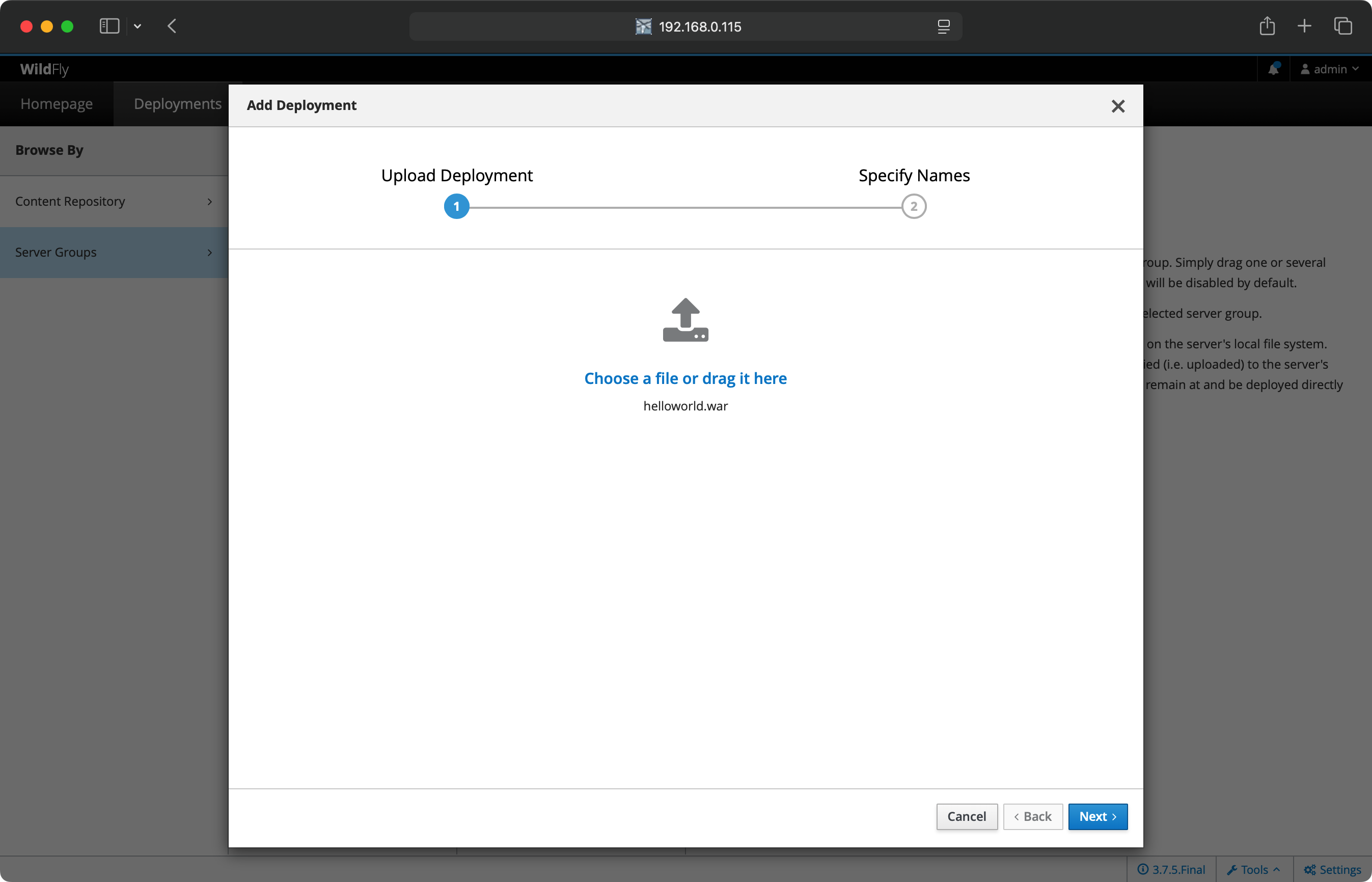
Then I clicked Next and left the deployment configuration fields as default:
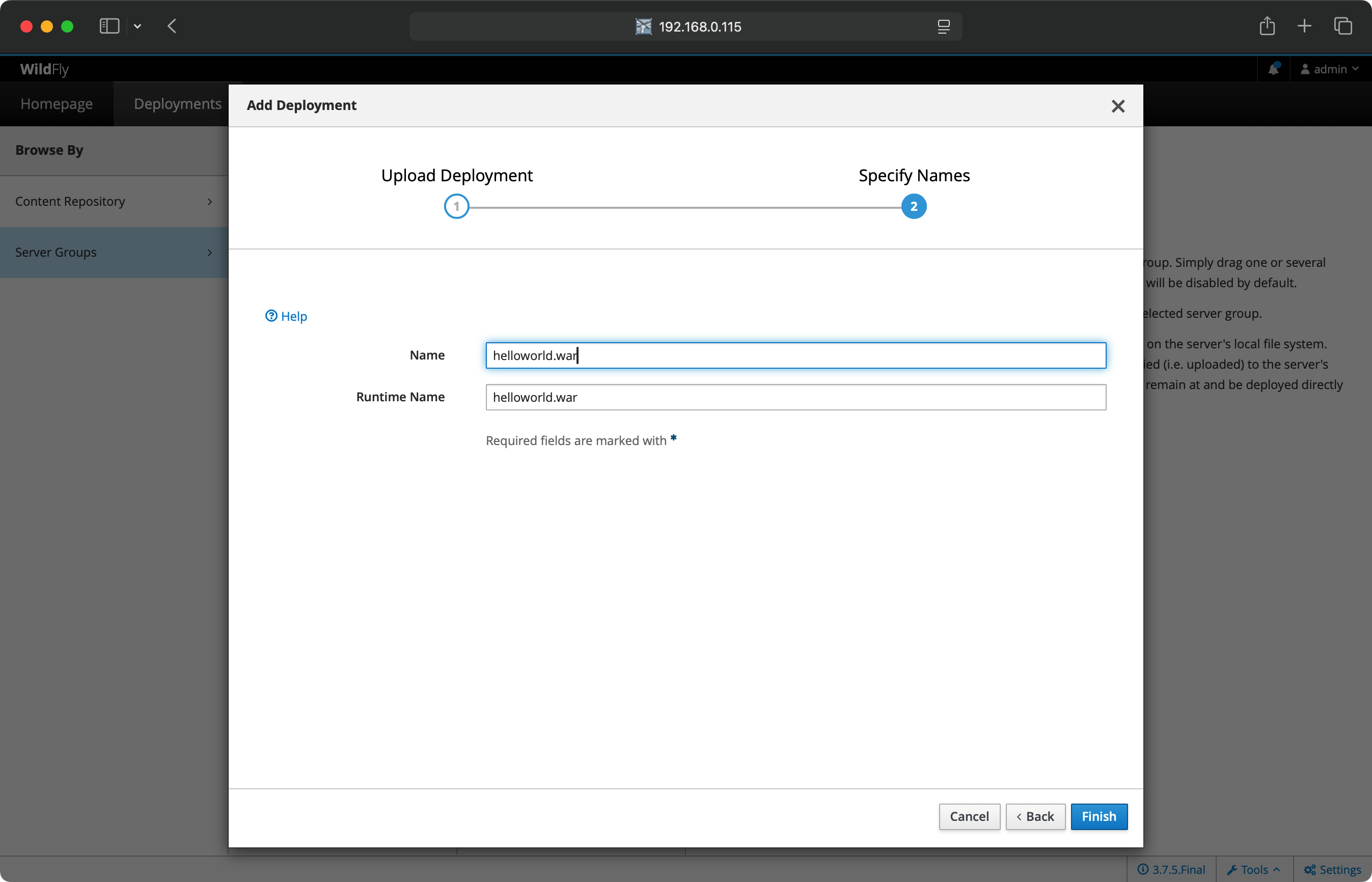
Then I clicked Finished and reached the Deployment successful page:
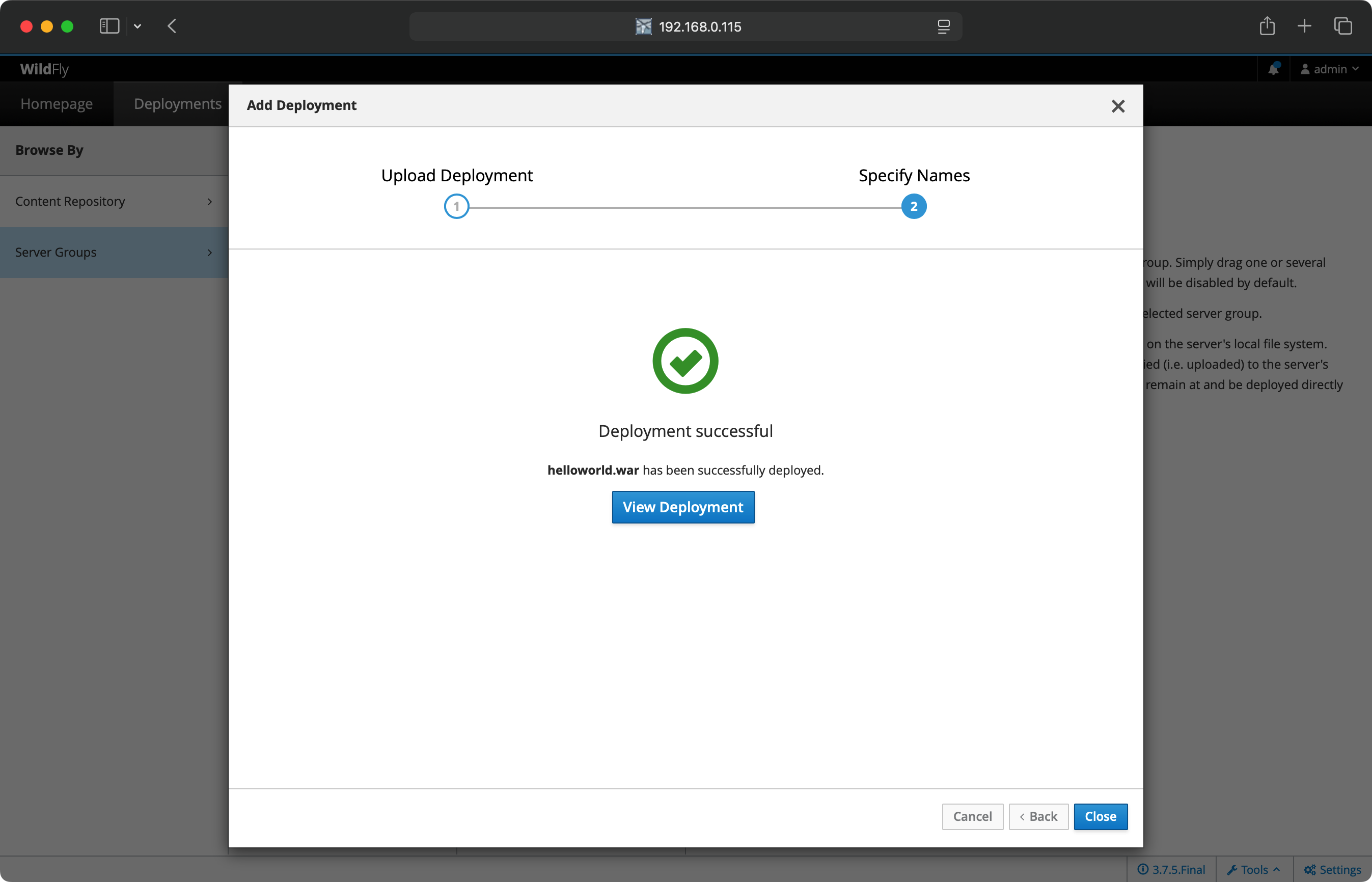
Now the helloworld.war is deployed to all the managed servers in the other-server-group. Now I click the Deployments on the top menu of the admin page, and then click the other-server-group, we can see that the helloworld.war is deployed into the server group:
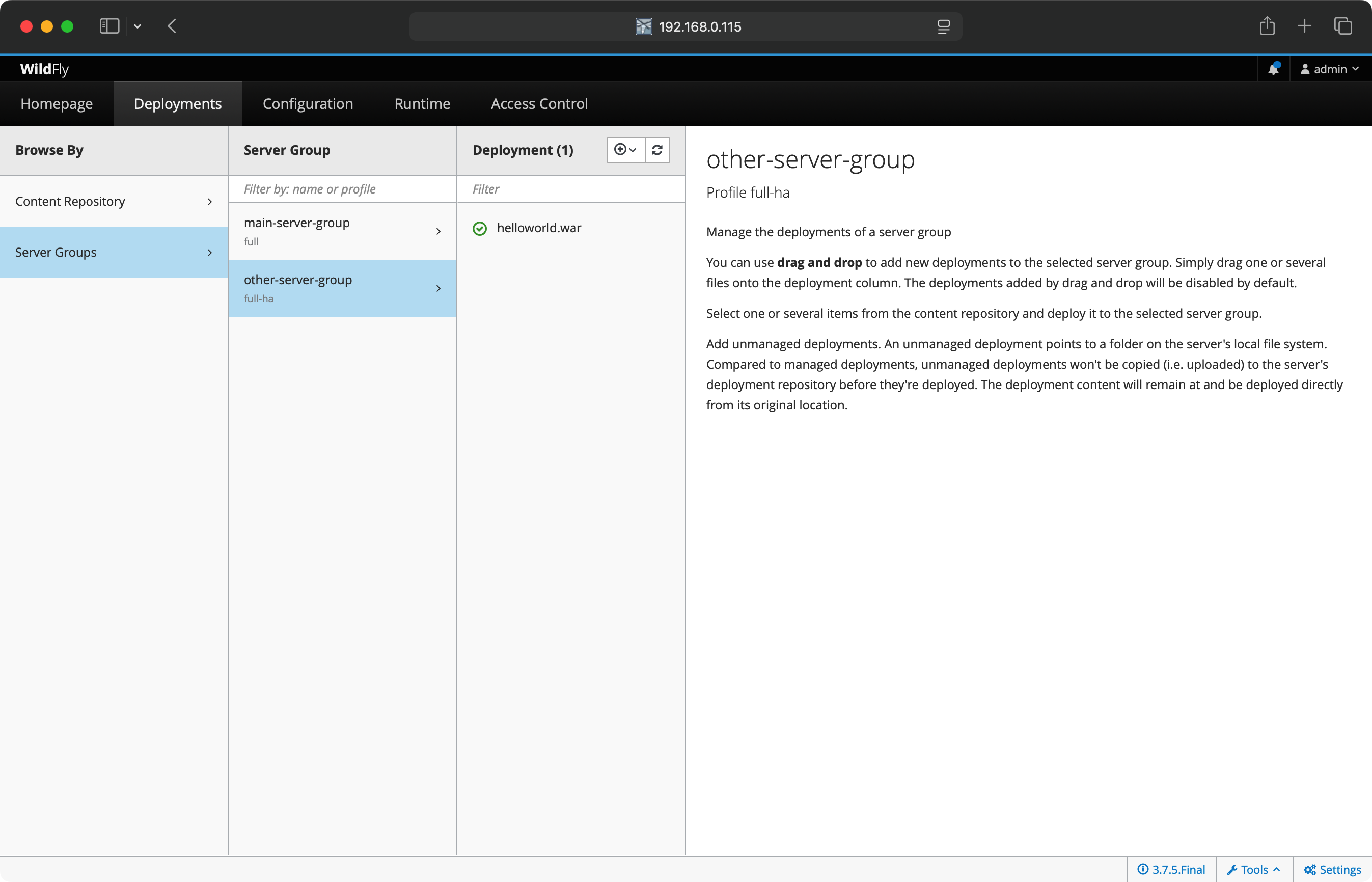
As the helloworld project is deployed, we can check the statuses of the two Host Controllers. I clicked the Runtime on top of the menu of the admin page, and then clicked the primary host tab, then I saw that server-three has not started yet:

This is because the auto-start property is configured to false in the host.xml of the primary host:
<server name="server-three" group="other-server-group" auto-start="false">
<jvm name="default"/>
<socket-bindings port-offset="250"/>
</server>So I need to click the Start button of the server-three:

After a while the server-three is started:

Because we didn’t configure the auto-start to false on the
Secondary Host Controller, so it’s already started:

From the above screenshots, we can see that the URL of server-two is http://192.168.0.113:8230, and the URL of server-three is http://192.168.0.115:8330. Their ports are different because the port-offset property settings are different. For server-three, the port-offset is configured like this:
<server name="server-three" group="other-server-group" auto-start="false">
<jvm name="default"/>
<socket-bindings port-offset="250"/>
</server>Because the port-offset is set to 250 for server-three, and the default HTTP port setting is 8080, so 8080+250=8330. For server-two, the configuration is like this:
<server name="server-two" group="other-server-group">
<socket-bindings port-offset="150"/>
</server>As the port-offset setting is 150, the calculated HTTP port is 8080+150=8330, which is expected. Now we can use the curl command to do the requests to both the Machine A and the Machine B to see if the helloworld project is deployed on two both of the machines:
❯ curl http://192.168.0.115:8330/helloworld/HelloWorld
<html><head><title>helloworld</title></head><body>
<h1>Hello World!</h1>
</body></html>❯ curl http://192.168.0.113:8230/helloworld/HelloWorld
<html><head><title>helloworld</title></head><body>
<h1>Hello World!</h1>
</body></html>From the above command output, we can see that the helloworld project is deployed two both hosts. Though they are running on two different machines, because these two hosts are in the same other-server-group and they are managed by the domain controller, so the project is deployed to both hosts.
I hope this blog post can be helpful to update your knowledge base to see how to use the domain mode in the most current WildFly release. For convenience, I have put the host.xml of the Primary Host Controller and the host-secondary.xml of the Secondary Host Controller online for reference[6].
 By 阿男
| February 12, 2025
By 阿男
| February 12, 2025
